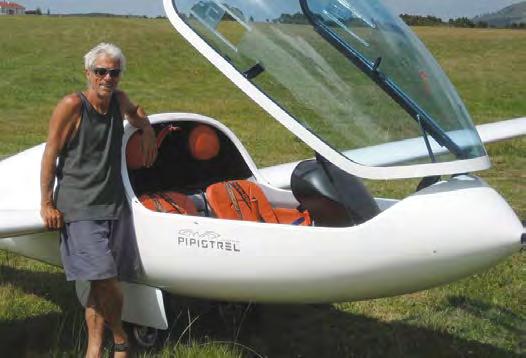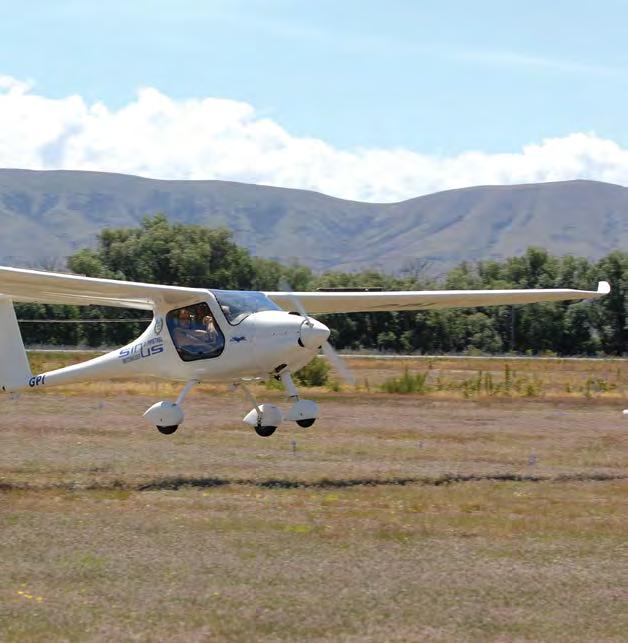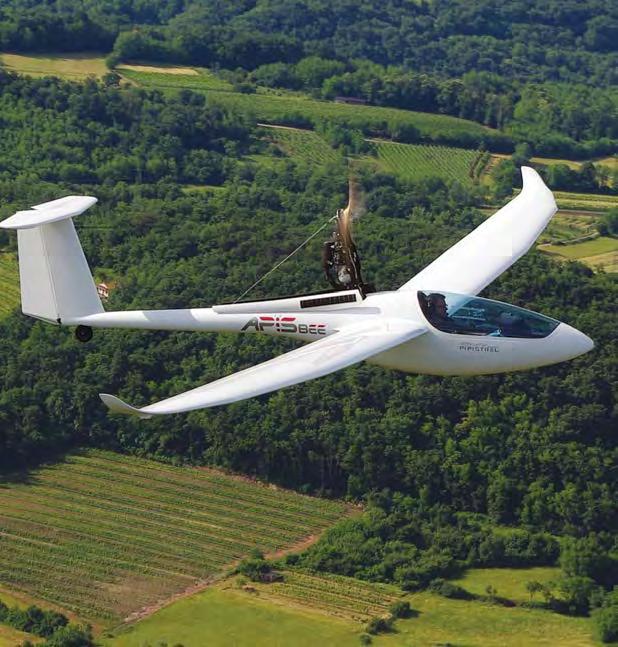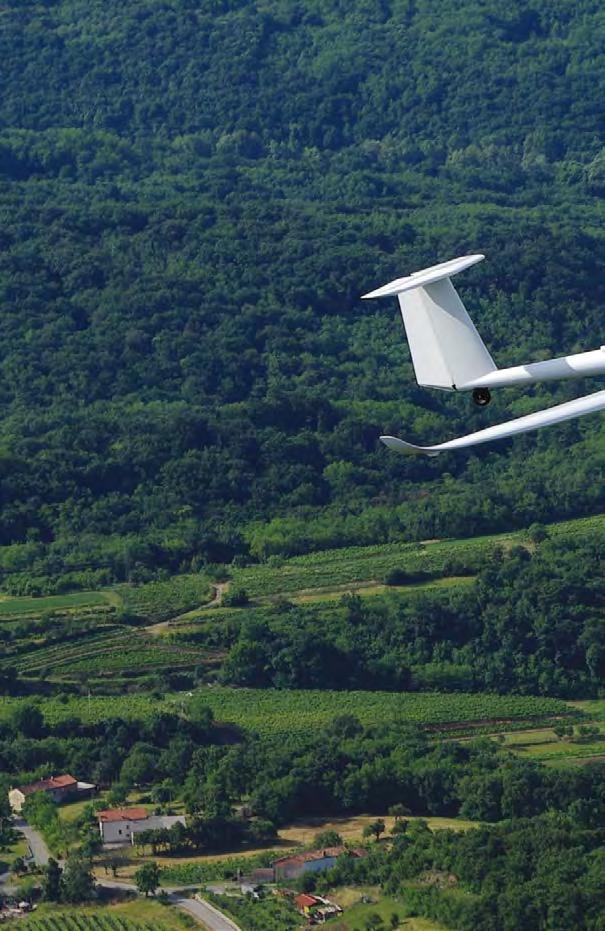
8 minute read
Three Gliders from Pipistrel
from SoaringNZ Issue 11
by mccawmedia

TAURUS
Advertisement
New Zealand now has two Pipistrel gliders, a Taurus and a Sinus. Their owners are thoroughly enjoying them. Alan Clarke, our local Pipistrel agent tells us a little about the gliders and Pipistrel’s new Apis Bee.
The First Taurus is flying in New Zealand
The first Taurus is now flying in NZ, a side-by-side two seater 41:1 with a retractable Rotax 503 engine. Alan Clarke, the NZ Pipistrel dealer, has flown with the new owner and says “it is everything they say it is. The new owner is just loving it, so we are leaving him in peace to enjoy it.”
The Taurus is now available in 3 versions – No engine, Petrol Rotax 503 engine or Electric engine. Pipistrel Sinus Kerikeri to Omarama and back last January
The NZ agents Alan and Donna Clarke live in Kerikeri and recently they flew in the Pipistrel Sinus to Omarama. They stayed for 4 weeks and flew most days, which Alan says was “simply awesome”.
Alan’s report: we got to Omarama on December 28 and set up camp on the airfield. Omarama seemed to have a 20 knot westerly almost every day but the camp was so sheltered that the tent didn’t flap even once; in many ways I think it’s the best campground in New Zealand.
What great foresight the man from Queenstown had – he built the camp, airfield, irrigation systems and so on – what a great job he did for gliding and NZ tourism alike.
I learned to fly in South Canterbury in 1964 and towed gliders in an Auster at Timaru and Omarama in 1965/1966. I went on to become a flying instructor for two years at Canterbury Aero Club and then became an ag pilot. In total I flew 6,000 hours fixed wing and 4,000 helicopter hours from 1966 to 1986. Then I had a break from flying for 18 years before taking up gliding in 2004. None the

less I came to Omarama with a healthy respect for the Southern Alps and no experience of wave flying at all.
My experiences...
Day 1 I found a nice thermal at Twizel to 9,000 ft. Day 2 I took Don from Canterbury with me who showed me around the area. Day 3 I motored up to wave at 9000 ft. Day 4 I found Grant who used to be a gliding instructor and got a lot more local guidance from him, over several flights. And so it went, gently feeling my way around a new area, so very different to gliding in North Island where thermals and ridge lift stop at 5,000 ft.
Eventually I found I could motor up to 4,000 ft and shut down, and work my way into wave at about 9,000 ft, sometimes taking up to an hour to get there. With no oxygen my wave flights were limited by altitude but none the less it was a great experience.
Using my Omarama experience I have now found local wave at home – in mid winter at 6,000 ft over the Hokianga harbour in a 35 knot SSW wind.
I have no experience at competition flying or in a 45:1 glider but these are some of my observations.
SINUS

Pipistrel Sinus 30:1 45:1 Glider Fly 800 miles to Omarama at 100 knots cruise at over 40 mpg Yes No Take off under own power Yes Tow plane needed Thermal Good Very Good Ridge Soar Good Very Good Cross Country Glide Limited Very Good Suit Competitive Gliding Probably not Yes Suitable for extreme mountain ridge soaring Probably not Yes Get home from anywhere Yes – just start the Rotax Not always Cheap to run Yes ? ? Two Seats Yes Not always Suitable for fun gliding Yes Yes Suitable for flight training Yes No Cost Affordable Expensive One man operations Yes No

Alan says, it is not a matter of which is best, it is more a question of what kind of flying do you want to do?
Alan can be contacted on 021 400 120 Website www.lightsportaircraft.co.nz Email alan@acfs.co.nz
APIS BEE

Report From Pipistrel Slovenia May 2009
A Special Double Celebration for Pipistrel and a market update.
On 15th May 2009 Pipistrel celebrated a special double jubilee. The two important occasions were:
Completion of the 300th aircraft from the Sinus-Virus family which is headed to Mr Bill Hunt from the USA
On the same day the 50th aircraft from the Taurus family left our production facility where it will find a new home in Brazil.
The Pipistrel team is proud to announce that even in these difficult times, we can boast a successful economic operation; in the first quarter of 2009 Pipistrel achieved a 35% increase of our production compared with the same time period in 2008.
Pipistrel achieved this feat by correctly anticipating the global economic trends and focusing on markets of countries less affected by the crisis (Arabian countries, South America and the Far East).
Pipistrel have realistic hopes to double the production output towards the end of 2009. Our customers are looking for more economical aircraft to operate, especially in flight training schools.
Pipistrel continues with the trend of intense investment into research and high-technology equipment and manufacturing development. In 2008 Pipistrel invested one quarter of the entire yearly turnover into research and development. We expect to do the same again in 2009.
At Pipistrel, we assign the greatest importance to the quality of our team, employing highly educated experts in our new Research Institute for Applied Science. Inside the new Institute, the development of a new four-seater is already well underway. This new aircraft is expected to trigger a large-scale revolution in the field of aviation.
At the moment Pipistrel is producing six to seven aircraft per month with close to 1000 aircraft in the past 22 years. We have just
begun the serial production of a self-launching glider, the singleseat Apis/Bee.
With the help of a global distributor network we have aircraft flying in 50 countries.
Philosophy
All Pipistrel aircraft represent the main philosophy of the company
The maximum possible use of energy efficiency The minimum possible air resistance, achieved with the clean aerodynamic shape The biggest possible safe payload The least amount of noise, pollutants and environmental contamination.
The results of this policy are aircraft which have 40% to 70% lower fuel consumption than other comparable aircraft and therefore put a lot less stress on our environment.
Pipistrel are especially proud of the Taurus Electro which made her maiden flight in 2007 and to this time remains the only two-seat electric plane in the world.
Pipistrel has proven by example that it is possible to be successful in business without polluting the environment. The facility in which Pipistrel work is 100% energy self sufficient and entirely powered from renewable sources of energy.
In 2008 Pipistrel claimed two prestigious titles.
For the 2nd consecutive year the Pipistrel Virus SW won the NASA GAT Challenge 2008, and the influential American magazine Popular Science declared the Pipistrel Taurus Electro as one of 10 most important innovations in 2008 in the “aviation and space” category.
For the future, Pipistrel have already started actively preparing for the next NASA challenge in the summer of 2011 where we will be introducing many new technologies never before used in aviation and Pipistrel continue to commit ourselves to continue promoting Slovenia through state-of-the-art technology based on ecology.
Ivo Boscarol – General manager

The re-released Pipistrel Apis Bee (Apis is Latin for Bee).
The Apis is a pre-moulded, composite build, single seat, single engine, mid-wing, classic, fixed or retractable undercarriage, high performance glider. It is available in 3 versions: no engine, or self launching petrol or electric engine. By concept, it is single-seat version of the Pipistrel Taurus. The Apis was originally designed by Pipistrel but was given to another company to produce – now the project is back with Pipistrel. After 12 months of development and with around 130 improvements, the Apis has just been re-released to world markets.

Costs
The Pure Glider Version is Euro 41,000 (plus shipping and GST) The Petrol Engine Version is Euro 54,000 (plus shipping & GST) The Electric Engine Version is Euro 77,000 (plus shipping & GST) The current delivery time is approximately 6 months (ex factory)
Pipistrel Sinus G loadings demystified
The Pipistrel Sinus is a motorglider, built to LTF-UL2003 (German) rules. It has to withstand +4G and -2G at VD (design speed, beyond VNE) and +5.3G and -2.65G at VB (turbulence penetration speed). Because the load case at VNE (VD) is much more critical (takes a stronger structure) +4G and -2G gets listed into Aircraft’s manual.
With pure gliders, as they do not tend to fly at speeds close to VNE that often, the other case (VB) gets listed into the manual – commonly +5.3G and -2.65G.
Each individual part on the aeroplane has been stress tested to at least +7.2G and -7.2G. The wings in particular have a break load
(tested independently at University of Stuttgart, Germany) of more than 10.8G and this is in hot atmosphere (55 degrees Centigrade). Tine Tomazic, Research & Development, Pipistrel, Slovenia says

“Believe us, the Sinus is very strong – just as strong if not stronger than the gliders flying in NZ at the moment.”
SPECS

14.97 m (49’ 1.5”) wingspan Glide ratio 40:1 Min sink rate 120 fpm Retractable undercarriage option Steerable tail wheel Hirth F33BS Engine 20 Litres Fuel Capacity Engine on climb 600 fpm Min sink speed 45 kts










